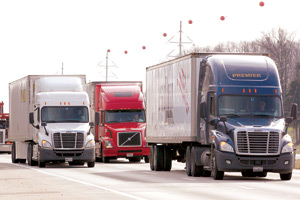Senior Reporter
US Fleet Size Surpasses 4 Million, Report Says

This story appears in the Aug. 29 print edition of Transport Topics.
The number of U.S. Class 8 vehicles in operation topped 4 million for the first time, clearing it by 9,000 vehicles, IHS Automotive reported.
That record was reached in the second quarter. The previous high of 3.97 million was set in the first quarter — just 29,000 shy of 4 million, according to IHS.
The vehicles in operation total has gradually increased each quarter since the third quarter of 2012.
The record quarter reflected fewer trucks being scrapped, said Gary Meteer, director of commercial solutions at IHS.
Turning to Class 8 registrations of tractors and straight trucks in the first half, Meteer said, “Tractors as a vehicle type within Class 8 are down almost 23%,” noting that they fell to 74,361, compared with 96,914 in the six-month period in 2015. “So that means within Class 8, you have buses and some of the heavy-duty dump trucks, and they’re doing OK.”
Straight truck registrations were up about 9% to 28,291 for the first six months, compared with 25,939 in the 2015 period, he said.
Through the first half of the year, new Class 8 registrations fell 14.7% to 111,510, compared with 130,673 in the 2015 period, according to IHS.
Also, year-to-date new registrations of Class 8 vehicles by fleets with more than 501 trucks dropped 23% to 50,075, compared with 65,021 in the 2015 period, IHS said.
“This is your transitional period,” said Don Ake, vice president of commercial vehicles at research firm FTR, who noted sales of Class 8 trucks were strong in 2014 and 2015, then freight cooled down. “Right now, you have too many trucks chasing too little freight, but not by much, not like a recession.”
Ake said some of those trucks have been sidelined, and fleets are showing greater caution in adding new Class 8 vehicles.
“Big fleets carried the industry out of the recession, and I think they have their business model where they want it,” Meeter said. “But I think there is still a little shakiness on the horizon for Class 8 [tractors].”
In the latest industry forecast from IHS, total registrations of Class 8 trucks in 2016 will be 220,000, or down 15% compared with 258,379 in 2015, then sink further in 2017. “And we believe it may even go down in 2018,” Meteer said.
New registrations by large fleets typically have accounted for about 50% of all Class 8 registrations, Meteer said, but year-to-date have slipped to a 44.9% share from 49.8% in 2015.
That trend is reinforced by the declines in Class 8 registrations in both the Central region, down 22.8%, and the Southern, off 14.8%, which are home to many large trucking companies, he added.
Meteer also said the IHS forecast predicts growth to slow in Classes 4-7 in the same periods, but “it will continue to slightly increase.”
He said the rental and leasing business was strong, especially for Class 6. Registrations in that class rose every month but April for a total of 32,316, up 14.6% compared with 27,923 in the 2015 period.
Overall, new commercial vehicle registrations for Classes 3-8 in the first six months totaled 350,722 units, a decline of 0.8% compared with the 2015 period, IHS reported.
Turning to new registrations from various manufacturers, which in some cases include medium- and heavy-duty vehicles, IHS said Freightliner had 65,380 registrations in the first half, down 5.5% compared with the 2015 period for a 19% share. Western Star had 2,880 for a 5.8% increase and a 1% share. Both are units of Daimler Trucks North America.
International Trucks, a brand of Navistar International Corp., had 21,366, down 14.5% for a 6% share.
Kenworth Truck Co. had 18,669, off 14.4% for a 5% share. Peterbilt Motors Co. had 16,789, down 6.9% for a 5% share. Both are units of Paccar Inc.
Volvo Trucks North America posted 11,406, off 27.7% for a 3% share. Mack Trucks had 9,430, down 9.7% for a 3% share. Both are brands of Volvo Group.
As for new trailer registrations, they are up almost 18% in the second half, driven by van trailers that account for 72% of the total. But Meteer said he was puzzled by the increase, given the decline in Class 8 tractor registrations.
“That has to do with fleets managing their portfolio [of equipment] and replacing trailers without correlating that to tractor purchases. You typically see them moving in sync,” he said.

